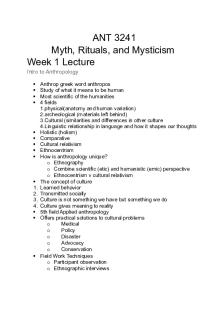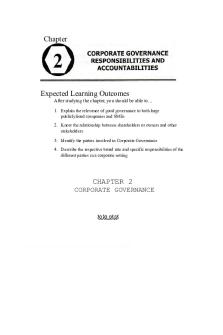ANT 385 2.2 - Lecture notes 2 PDF

| Title | ANT 385 2.2 - Lecture notes 2 |
|---|---|
| Author | Tessa Goetz |
| Course | Special Topics: Anthropology |
| Institution | Emory University |
| Pages | 4 |
| File Size | 54.9 KB |
| File Type | |
| Total Downloads | 58 |
| Total Views | 142 |
Summary
Adrian Jaeggi
...
Description
ANT 385 2.2 Evolutionary Psychology
While HBE explains behavioral variation, Ev. Psych is interested in the universal architecture of the mind Goal: to identify evolved psych mechanisms, usually conceptualized as algorithms o
Ex. Social emotions: anger, gratitude, sympathy, etc. As calibrators of social change
Anger – you want someone to treat you better – energy rises, temp rises, testosterone, all these changes serve purpose to show other person that you're willing to fight and aren't happy
Gratitude – someone treated you well and you have to up your treatment of them in the future
The mind is thought to consist of many such adaptations, the brain is literally treated as a computer
99% of human evolutionary history was spent as small scale hunter-gatherers, most psych mechanisms are thought to be adapted to that lifestyle (EEA – environment of evolutionary adaptiveness)
This knowledge of ancestors can make predictions of design of unknown psych mechanisms
o
This is called adaptive thinking
o
Ex. Sex differences in spatial cognition
Men are better at some aspects – from hunting, going long distances, or for finding a mate, or movement, large scale places
Women are better at some aspects – women better at remembering location at food resources, exactly where specific places are
Design features of known psych mechanisms can be explained as adaptations to ancestral lifestyles o
Reverse engineering
o
Ex. Wason card-sorting task
o
Ex. Westermarck effect: if you lived with someone as a kid you aren't attracted to them as an adult, this is to avoid incest
Key Concepts: evolved Psychological Mechanisms
What evolves is not behavior, but the underlying mechanisms o That’s where we should see adaptions (design) o
Ex. Jealousy – universal emotion that's an adaptation for detecting cheating in a relationship and trying to prevent it so that your genes can continue
Human universals
Can produce context-dependent behavior (See HBE) by responding to environmental cues that were reliably associated with different fitness outcomes o
Life history theory
Kids like attachment because in the past because of hunter and gatherers and needed mom to stay safe o
Book: Attachment – John Bowlby
o
Argument is that play is in the natural way kids learn
o
But nowadays school is longer and more structured, so another reason kids are having a longer time focusing
Key concepts: Domain specificity
Mind consists of adaptations for specific tasks o Visual perception, language, mate choice, parenting, friendship, disease avoidance, social exchange, etc. o
Contra 'Standard Social Science Model'
Ex. Garcia learning experiments
Had rats ate bad food and later exposed them to radiation and the rats felt nauseous bc of radiation so they avoided that food
Also gave them electric shock after, but they were slower to learn that association bc outer pain not as associated w nausea and food
But light and shock were associated w each other bc external
Key concepts: Adaptive thinking and reverse engineering
Adaptive thinking: 1. Develop models of adaptive problems: e.g. altruism
2. How did these problems look in the EEA? E.g. necessity for helping and avoiding incest, possible cures of kinship 3. Develop a computational model: e.g. kinship estimator
Case studies: Cheater detection o
Wason selection task:
People are better at solving the same logical task when framed differently
Case studies: Sex differences in mate choice
o
Sexual selection and parental investment theory:
o
Females should be choosy, seek investment
o
Males should seek many (fertile) mates, invest only if paternity confidence is high
o
David Buss' survey of 10,000 people in 37 countries
o
Universal sex differences
Men like men that’s slightly older and women like men slightly younger
o
Bc men want someone more fertile, women want someone who has resources
Not universal:
Culture plays a part
Found that chastity isn't as big of a deal in the US
Case studies: Homicide
o
Kin selection & parental investment theory:
o
Cinderella effect
Step parents worse than biological parents
More likely for abuse or for killing kids
60x more likely to be killed by step fathers
Intrasexual selection and male-male copetition:
Most homicides are male-male bc have to take greater risks in their competition than females
Almost all homicides are one man killing another
Fight over status
Income inequality – change inequality and get less crime
Disgust
o
Evolved defense against pathogens, non-beneficial relationships (sexual, cooperative)
o
Disease-relevant stimuli perceived as more disgusting
o
More so when more susceptible to disease
Pregnancy
Strangers
High-pathogen environments
Critical evaluation: EEA
o
No one would argue that the EEA is a specific place and time
o
It’s the weighted sum of past selection pressures that have acted on a specific trait
Nonetheless, inferences about past selection from modern hunter-gatherers can be tricky
Huge variation in environments, lifestyles
Technological change
Etc.
Critical Evaluation: Domain-Specificity...
Similar Free PDFs

ANT 385 2.2 - Lecture notes 2
- 4 Pages

ANT 3241 - lecture notes
- 14 Pages

2:28 - Lecture notes 22
- 5 Pages

Chapter 22 - Lecture notes 22
- 4 Pages

Chapter 22 - Lecture notes 22
- 4 Pages

385 CURE - Lecture notes 1-3
- 12 Pages

FINA 385 - fina 385
- 19 Pages

22 - Lecture notes 1
- 14 Pages

282 lecture notes lecture 22
- 93 Pages

Lecture Notes 1/22
- 2 Pages

Lecture notes 22
- 28 Pages

Unit-2 DCN - Lecture notes 10-22
- 20 Pages

Ch6 22.40.37 22 - Lecture notes 6-22
- 26 Pages

Psychology 385 Chapter 5 Notes
- 13 Pages

Ch7 22 - Lecture notes 7
- 26 Pages
Popular Institutions
- Tinajero National High School - Annex
- Politeknik Caltex Riau
- Yokohama City University
- SGT University
- University of Al-Qadisiyah
- Divine Word College of Vigan
- Techniek College Rotterdam
- Universidade de Santiago
- Universiti Teknologi MARA Cawangan Johor Kampus Pasir Gudang
- Poltekkes Kemenkes Yogyakarta
- Baguio City National High School
- Colegio san marcos
- preparatoria uno
- Centro de Bachillerato Tecnológico Industrial y de Servicios No. 107
- Dalian Maritime University
- Quang Trung Secondary School
- Colegio Tecnológico en Informática
- Corporación Regional de Educación Superior
- Grupo CEDVA
- Dar Al Uloom University
- Centro de Estudios Preuniversitarios de la Universidad Nacional de Ingeniería
- 上智大学
- Aakash International School, Nuna Majara
- San Felipe Neri Catholic School
- Kang Chiao International School - New Taipei City
- Misamis Occidental National High School
- Institución Educativa Escuela Normal Juan Ladrilleros
- Kolehiyo ng Pantukan
- Batanes State College
- Instituto Continental
- Sekolah Menengah Kejuruan Kesehatan Kaltara (Tarakan)
- Colegio de La Inmaculada Concepcion - Cebu
